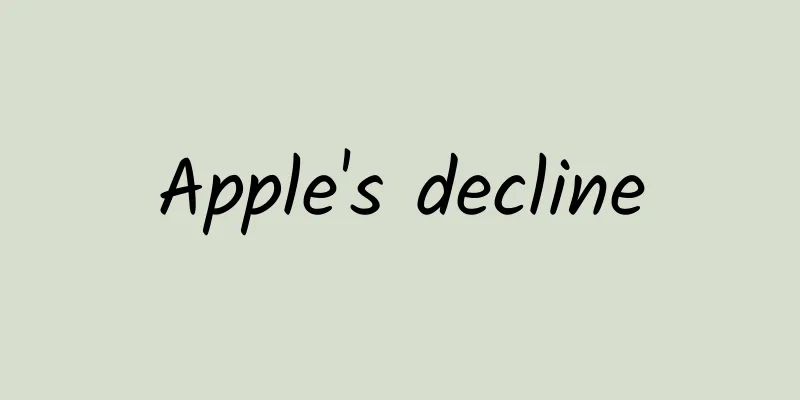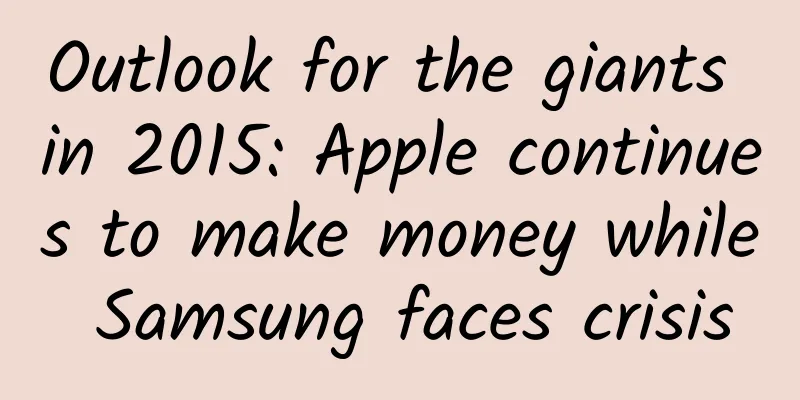Apple's decline

|
"Is there any signal?" two Apple users greeted each other after meeting. The signals of iPhone XS and iPhone XS Max have caused headaches for users, and the high prices have caused their sales to decline, which has put Apple in a tight spot. The shipment volume of iPhone XR, which is positioned as a "low-priced" model, is also far below expectations. The price of iPhone XR has been falling. It is reported that some distributors even lowered the price by 1,500 yuan. iPhone XR is not selling well. Even though it is cheaper than iPhone XS, it is still more expensive than Android flagship phones. Even with the colorful back cover that pays tribute to iPhone 5c, it cannot make up for the lack of competitiveness of iPhone XR. Looking around Apple, its former followers are now catching up at a faster pace, and Apple's new models will face fierce competition in 2018. In addition, Qualcomm's patent lawsuit against Apple in the Chinese market has made the situation worse, and all these signs reflect Apple's anxiety. Outdated product strategy According to the iPhone's regular update strategy, every time a generation is significantly upgraded, there will be a "small patch" iteration. The iPhone XS has a faster Face ID, a more powerful processor, and most importantly, it is more expensive. The 2018 iPhone XS has no obvious appearance changes compared to last year's iPhone X - and this change happens to be the most attractive point for mass consumers. According to a UBS survey, Chinese consumers' willingness to buy iPhones has dropped by 6% compared to last year, hitting a new low. Chinese consumers are no longer as interested in Apple's traditional update strategy as before. The only major breakthrough in the appearance of the new iPhone in 2018 is the enlarged screen, the iPhone XS Max. It is the iPhone with the largest screen in history, and also the heaviest, weighing 208g. If you put it in the pocket of your sweatpants, you have to tie the waistband tightly. The iPhone XS and iPhone XS Max still follow the "large-screen dual flagship" strategy. However, this strategy can be traced back to the Samsung Galaxy Note in 2011. After Samsung tasted the sweetness, it relied on this strategy to conquer the Chinese high-end smartphone market, and attracted Huawei and Apple to follow suit. In 2014, Apple CEO Cook came up with a new slogan for the new iPhone 6 and iPhone 6 Plus: "Bigger than bigger." The 5.5-inch iPhone 6 Plus refreshed the screen size of the iPhone at that time. That year, the "big screen dual flagship" strategy drove Apple fans crazy, and the new phones were hard to come by. On the third day after the launch, Apple proudly announced that the iPhone 6 series had sold over 10 million units. Apple fan Lily still remembers how she felt when she used the iPhone 6 Plus: "From a 4-inch screen to a 5.5-inch screen, this leap is so cool." But it’s 2018 now, and the iPhone update strategy seems a bit outdated. In fact, the strategy has already shown signs of fatigue after the release of iPhone 7, and Apple did not announce the sales of its series of models for two weeks. This year’s Apple product strategy cannot keep up with other Chinese smartphone manufacturers. Technical encounter According to a report by market research company Canalys, China's smartphone market shipments fell 4% year-on-year in 2017. This is the largest decline in the history of China's smartphones. Domestic manufacturers have smelled the smoke of war in 2018. Faced with an increasingly tightening market, the only way to break out of the predicament is to get rid of the clichéd competition at the hardware level and turn to a battlefield that tests technology research and development. Since the beginning of the year, domestic manufacturers have been constantly trying and perfecting new technologies. Under-screen fingerprint, rear triple cameras, slide rail technology, 3D face unlocking, ToF, and even fast charging technology that Apple doesn't care about, domestic manufacturers have tried all the new technologies they can. The Chinese smartphone market was flourishing in 2018. Consumers have more diverse choices, and the constantly self-optimizing Android system, the frequent launch of new technologies, and the ecosystem built by manufacturers have gradually consolidated their voice. IDC data shows that Apple's shipments in the Chinese market fell year-on-year for two consecutive quarters in 2018. Huawei, OPPO, vivo and Xiaomi took the top four places in shipments, closing in on Apple's territory. Apple actually has sufficient technical reserves. The Face ID on the iPhone X was epoch-making at the time. There is even a saying that "Apple's Face ID is at least two and a half years ahead of the Android camp." But this saying was broken by new phones from OPPO and Xiaomi less than a year later, and the subsequent ToF technology set another benchmark for facial recognition.
This year's iPhone XS series of mobile phones seem to be lacking in strength in the face of surrounding innovations. To be precise, Apple encountered a technological encounter this year, and Apple's performance shows that it is not fully prepared for this battle. Although iPhone XS Max and iPhone XR have made special dual-SIM optimizations for the Chinese market, this feature is no longer news in the Android camp. Apple's attempt to use this feature to snatch users from the Android camp is not convincing enough. Overwhelmed In fact, Apple has a strategy to deal with the increasingly sluggish demand in the smartphone market - raising prices. The starting price of iPhone XS has been increased by RMB 300 compared to iPhone X, and the price of the large-screen iPhone XS Max has been raised to a historic high of RMB 12,799. Tianfeng International Securities analyst Ming-Chi Kuo said that despite the decline in iPhone shipments, the iPhone will still be able to maintain overall revenue growth in 2019 by increasing unit prices. However, this is indeed one of the responses of the entire market. In addition to investing in the research and development of new technologies, domestic manufacturers are also constantly launching high-end flagship phones to increase prices, gradually moving closer to the comfort zone of Apple's price. Huawei Mate 20 Pro, OPPO Find X, vivo NEX and other products are some of the representatives of higher prices. The starting price of vivo NEX dual-screen version is close to 5,000 yuan, which is another 1,000 yuan higher than the previous generation. In the more price-sensitive Indian market, some users said: "I won't spend $1,000 to buy an iPhone, but I can now buy a OnePlus phone with the same level of configuration for half the price." In other words, even if domestic manufacturers raise their prices, they will not exceed the starting price of 6,499 yuan for the "low-priced" iPhone XR. Under such a comparison, price-sensitive users may choose products with a better cost-effectiveness. On the other hand, apart from technical factors, this year's new iPhone faces a challenge in terms of aesthetics. After the iPhone XS series sales fell short of expectations, Apple shifted its focus to the iPhone XR. The huge iPhone billboards on the streets featured the iPhone XR with a colorful back cover. In order to highlight the colorful back cover of iPhone XR, Apple launched a transparent protective case worth RMB 329. At first glance, it looks no different from a clear case. This is probably the most expensive clear case in history and has become a focus of discussion. However, a survey by market analysis firm Strategy Analytics found that the colorful iPhone XR is not very popular. Apple's colorful strategy does not seem to have the expected effect. Let's turn our attention to the Android camp. The aurora color of the Huawei P20 series almost set the trend of mobile phone back covers this year, and the Android camp has been exploring the back covers in an endless stream. The six colors of the iPhone XR are not so dazzling in comparison. Although we have to admit that the glass back cover of the iPhone XR does have a stronger texture than the plastic body of the iPhone 5c, and it also accidentally hits the popular color of 2019, "Coral Orange", but Apple, which is famous for its innovation, cannot be equated with "technology based on changing the shell". The Chinese smartphone market is probably one of the most diversified markets in the world, and it is also one of the fastest growing markets. Since Apple officially entered the Chinese market in 2009, it has relied on its strong brand power, advanced technology research and development, and a complete ecological closed loop to maintain its image as a strong player in the smartphone market. It has influenced many domestic mobile phone manufacturers and witnessed the rise of Chinese smartphones. The Chinese smartphone market is developing rapidly, but Apple has not changed its role in time to adapt to the fierce market competition. Outdated product strategies and lack of sincere technological innovation have put Apple in an extremely passive position this year. If Apple follows its regular update strategy, the iPhone will be significantly updated in 2019. Apple, with its strong technical reserves, may still give us surprises, but how to define "surprises" depends on the actions of its competitors. |
>>: A joke about the development process of Mobile Jianghu
Recommend
It’s not worse than a camera. How to take high-quality photos with a mobile phone?
Compared with SLR cameras, mobile phone photograph...
French diesel car cheating investigation: Opel, Volkswagen and Renault are still suspects
According to The Detroit News, French investigato...
Online event promotion planning and solution analysis
For operators, event operation is a very importan...
The new advertising law is finally here. If you don’t want your APP to be removed from the shelves, quickly change the app description!
In the 360 developer communication group this a...
South Korea and France team up to develop driverless car technology
South Korea's trade minister recently announc...
How Dirty Is Ice in Drinks? Now You Know the Truth...
The temperature has been over 40 degrees Celsius ...
iQIYI's Duan Youqiao: Living room and bedroom are the most important markets for VR
In the Chinese Internet circle, where the term &q...
The entire process of building and optimizing information flow advertising accounts
Too little exposure and no sales? How to set a re...
iOS 9 fonts and more
[[149610]] On September 9, 2015, Apple released a...
A complete method for running a good event, with 12 cases
Even if the product's features and experience...
APP operation and promotion: How to create a good landing page to promote user growth?
The ultimate goal of the landing page is to serve...
Army Day | China's aircraft carrier opens the "three-ship passenger" era, experts explain electromagnetic catapult and conventional power
Today is the Army Day. For 95 years, we have over...
Font size is bigger and clearer! WeChat: Nearly 4.07 million users have activated caring mode
[[427576]] News on October 8, today, WeChat offic...
Are you going to cause trouble during the festival? If you don't understand these, you are just amusing yourself
As the saying goes, every festive occasion makes ...
2500 words user retention analysis
Faced with the current situation of difficulty in...









